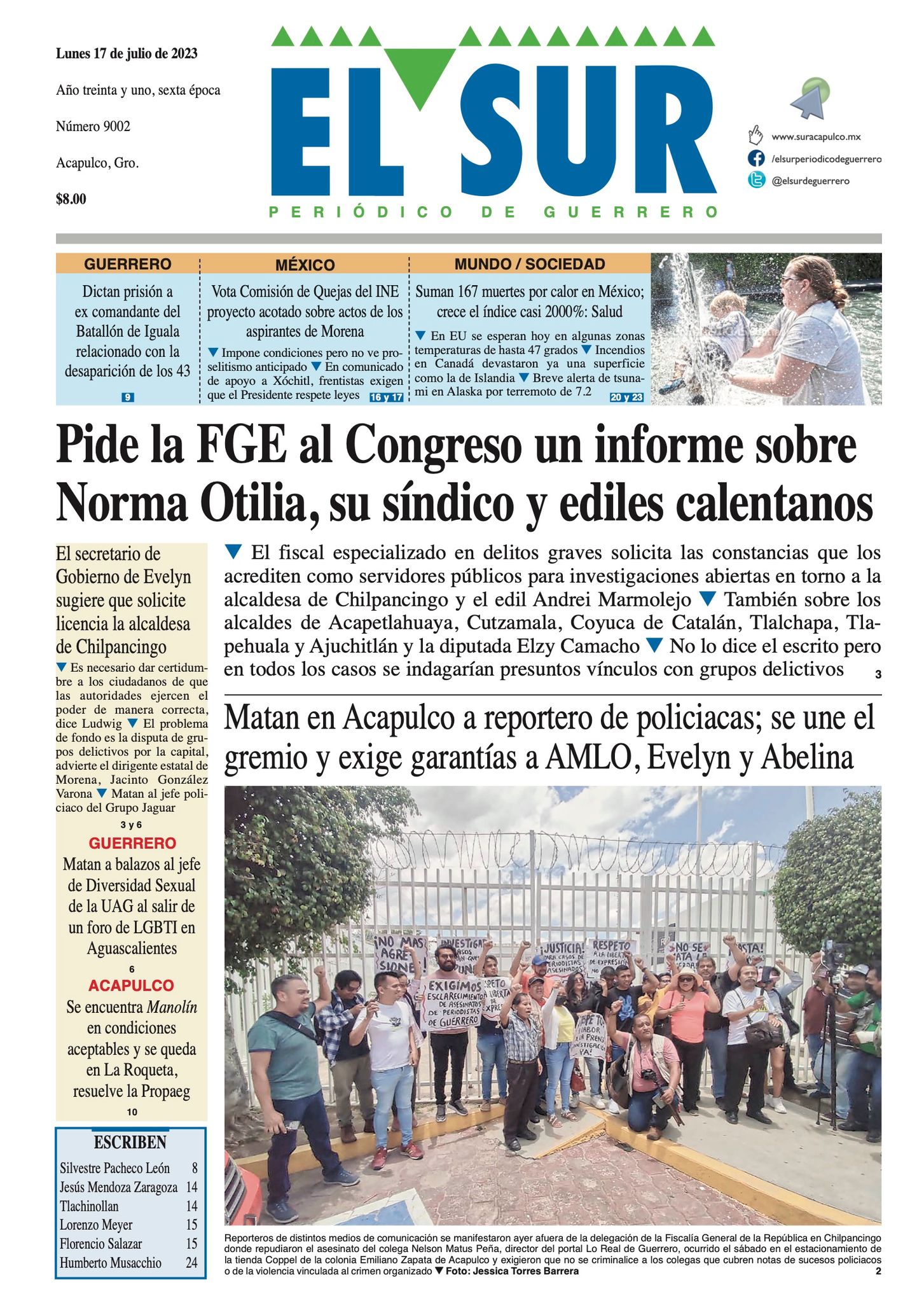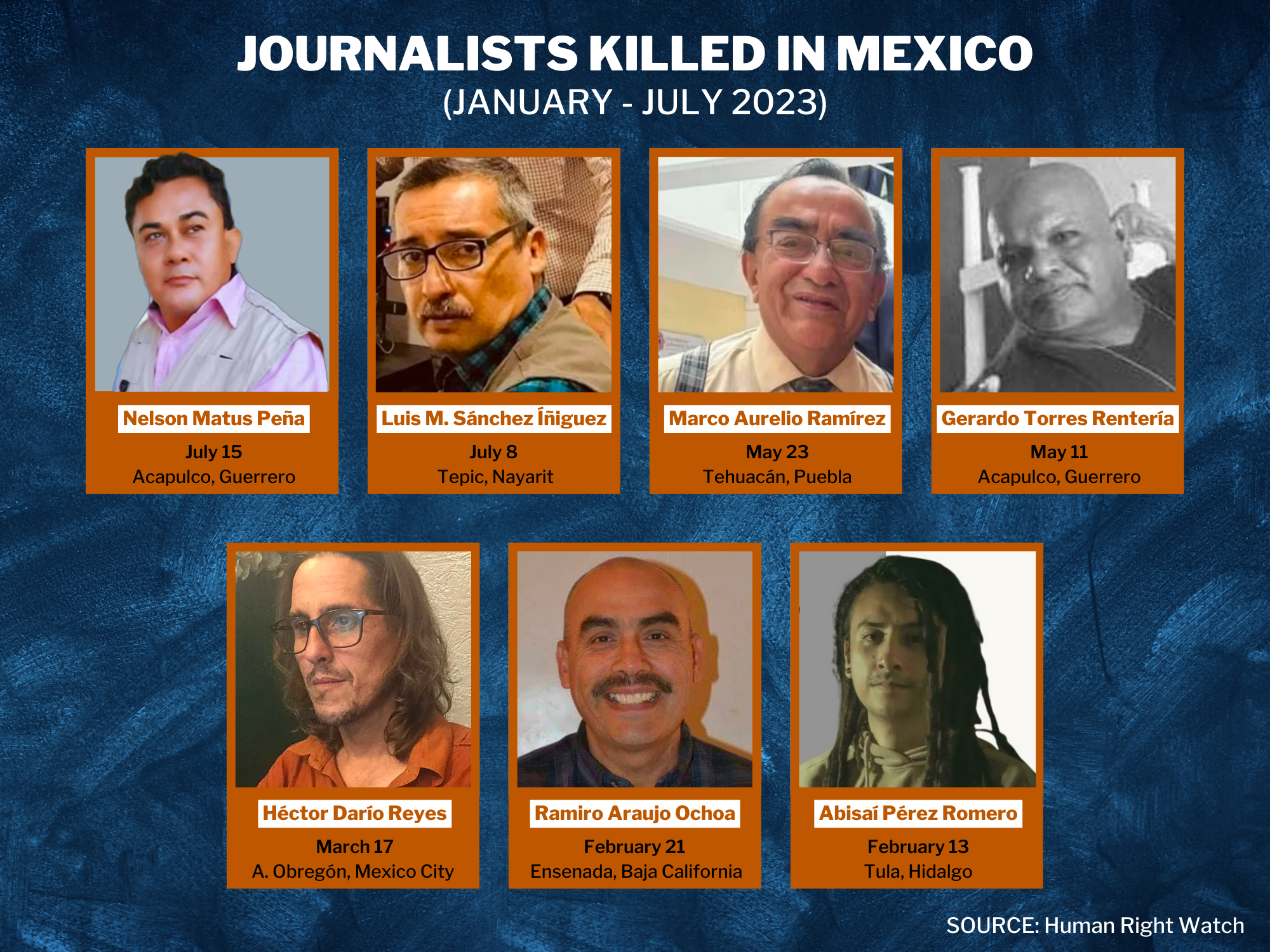Nelson Matus was outside a department store in the port of Acapulco, in the Mexican state of Guerrero, on Saturday, July 15. Shortly after 3:00 p.m., armed men approached him and fired several shots as he was about to get into his car. Matus fell instantly, victim to gunshot wounds to the body and head. He lost his life a few minutes later, according to local press reports.
Matus was the director of Lo Real de Guerrero, a popular digital news outlet specializing in the nota roja beat [crime news] as well as citizen complaints in Acapulco and its surroundings. The journalist became the seventh communicator murdered in Mexico so far in 2023, and the second in Acapulco in less than three months.
The month of July brought an escalation of violence against journalism in Mexico, with at least two murders. And with it came a wave of condemnation from national and international organizations, as well as a desperate cry from Mexican press members for their safety.
"Acapulco’s journalists [...] we strongly condemn the murder of our colleague Nelson Matus Peña, which took place in broad daylight. [...] Is there a list for murdering journalists in Acapulco? Will we be next? We don't know, but we want to denounce it. How many more journalists, President Andrés Manuel López Obrador?" wrote journalists' associations in the state of Guerrero in an open letter on the same day of the crime.

Following the murder of Nelson Matus, journalists from Acapulco gathered to protest and demand justice and protection. (Photo: El Sur de Guerrero Facebook)
Matus had already suffered two attempts on his life. One of them was in 2019, when individuals shot at him while he was driving his vehicle, but the journalist escaped unharmed. Two years earlier, he had also survived an armed attack.
Just a week before Matus' murder, on July 8, journalist Luis Martín Sánchez Íñiguez was found dead and with evidence of violence in the municipality of Tepic, Nayarit state, according to the organization Article 19. Sánchez Íñiguez, who was a correspondent for the newspaper La Jornada and specialized in political news, had been reported missing three days earlier, on July 5.
That day, the journalist contacted his wife, who was in another municipality, to tell her they had lost power at their home. That was the last communication with Sánchez Íñiguez. The following day, when one of his sons went to the house to check in on him, he found the place empty. Also missing from the home were the journalist's work computer, his cell phone, a portable hard drive and the ID that identified him as a correspondent for La Jornada, according to what the family reported to authorities.
Nayarit's Attorney General's Office confirmed on July 9 that the communicator's body had been found along with two pieces of cardboard that had a handwritten message allegedly linking the murder to the victim's journalistic work.
"There’s a saying: 'The truth will set us free.' The truth killed him! Because he didn't leave, they took him! And if he wasn't afraid, neither are we. Justice will be done here on Earth as it is in Heaven," said Sánchez Íñiguez's daughter during his funeral, and then asked for a minute of applause for her father's 30-year journalistic career.
Several freedom of expression organizations condemned the recent murders of journalists in Mexico. Article 19 demanded that the prosecutors of Guerrero and Nayarit carry out diligent investigations to ensure justice in the murders of Matus and Sánchez Íñiguez, respectively. The investigations should apply in both cases the Homologated Protocol for Crimes Against Freedom of Expression, an instrument of the federal government's Ministry of the Interior that seeks to establish the causes of a crime and its possible relationship with the detriment of freedom of expression, according to Article 19.
The Committee to Protect Journalists (CPJ) also demanded that authorities find those responsible for both murders. It also pointed out that, in a country with an extensive prevalence of corruption and organized crime, such as Mexico, it is difficult to determine whether journalists are attacked because of their work or as part of a dangerous environment that rules several regions.
"Mexican journalist Nelson Matus Peña’s brutal killing is all the more shocking given that his life was taken only one week after another reporter, Luis Martín Sánchez, was found dead in Nayarit," said Jan-Albert Hootsen, CPJ's representative in Mexico. "Sadly, Mexican authorities continue to prove ineffective at protecting journalists, who are frequently targeted by such attacks."
The Inter American Press Association (IAPA) lamented that journalists in Acapulco and other areas of Mexico carry out their work in fear and unprotected. The organization said in a press release that as long as violence against members of the press remains unpunished, it will continue to send a message that there is "free rein" to those who want to attack journalists.
"We reiterate our demand that the government act firmly in the face of murders against journalists, administer justice, curb the violence they suffer, and demonstrate its commitment to press freedom," said Carlos Jornet, chairman of IAPA's Committee on Freedom of the Press and Information.
The United Nations Organization in Mexico also condemned the murders and sent condolences to their families. In a statement, the organization urged the Mexican State to adopt effective and structural prevention measures to put an end to violence against those who exercise the right to defend freedom of expression through journalism.

Seven journalists have been killed as of July of this year, although the link between all the murders and their work as journalists has yet to be determined. (Photos: Facebook, CPJ and Artículo 19)
For its part, UNESCO expressed concern about the potential impact journalists’ murders in Mexico have on the country's information ecosystem.
"Attacks on journalists are leading to the creation of zones of silence where journalists self-censor, and where citizens are deprived of access to free and pluralistic information," said Audrey Azoulay, director general of UNESCO.
In separate statements, the International Federation of Journalists condemned the crimes against Matus and Sánchez Íñiguez and expressed its solidarity with press workers who have taken action in Mexico to demand justice. In both cases, the IFJ called on municipal and state authorities to coordinate with the Attorney General's Office (FGR, by its Spanish acronym) to carry out investigations under the Standard Protocol for the Investigation of Crimes Committed against Freedom of Expression.
"The lack of guarantees for journalists to practice their work in a safe manner systematically damages freedom of expression and the right to information of the Mexican people, and therefore affects democracy," the organization said.
Before becoming a journalist, Nelson Matus had been a member of the Acapulco Fire Department. Thanks to this, he established close relationships with members of that and other security bodies, such as the Police and the Red Cross.
After working as a police reporter for Alarma magazine and the digital news outlet Agora Guerrero, Matus founded his own news outlet, Lo Real de Guerrero, which became a standard for crime news in the state. On several occasions the outlet’s Facebook page was taken down, in one of them, after exceeding one million followers. At the time of its founder's death, the site had registered 267 thousand followers.
The contacts Matus created during his time as a firefighter helped him stand out in his coverage of crime and accidents.
"We all have our secrets as far as information sources go. His secret was that [...] he developed many relationships among police officers, firefighters, people who deal with accidents. And from there on, he had his contacts who would tell him where accidents had taken place, where someone had been executed and all that. That's why he would arrive immediately," journalist Miguel Ángel Mata, president of the Journalists' Club of Guerrero and director of the digital news outlet Síntesis de Guerrero, told LatAm Journalism Review (LJR).
The administration of Governor Zeferino Torreblanca in Guerrero, between 2005 and 2011, is remembered by journalists in that state as one in which freedom of the press was most damaged. Not only because of Torreblanca's discretionary use of official advertising to "reward" or "punish" news outlets, but also because during his administration 10 journalists were murdered, according to a tally by Síntesis de Guerrero.

Lo Real de Guerrero, the digital media outlet founded by Matus, became a referent of the crime news coverage in the state. (Photo: Lo Real de Guerrero Facebook).
According to Mata, during that six-year term, the sources of information in the local Prosecutor's Offices were closed to the media and remain so to this day. Rarely do justice authorities give information about crimes to reporters and although these institutions have a Social Communication office, it rarely responds to requests for information.
"So when Nelson burst in with this new method of having contacts who told him there’s a dead person here, a wounded person there, an accident over here, in some ways he opened up the police source again and allowed us all to join in that dynamic — to look for sources on the outside. Even if the government doesn't inform us, we have to publish," Mata said.
The promptness with which Matus arrived at the scene of crimes and accidents raised suspicions that it was the criminals who tipped him off about homicides in Acapulco. There was even a rumor that the journalist was acting as a spokesman for a cartel.
The criminalization of journalists is a common form of aggression against the press in Guerrero, Mata said. After the latest cases of murders of journalists in that state, there have been immediate accusations linking the victims to organized crime, some of them coming from the authorities themselves.
"The investigations [into the murders of journalists] do not make progress, they only say that it had to do with organized crime or that our colleagues were involved in stuff having to do with crime. This worries us a lot because oftentimes the aggressions come from politicians or government officials, especially municipal ones. And they cover themselves under the cloak of crime," Mata said.
Moments after the murder of Gerardo Torres — who was a correspondent for Reuters, Telemundo and TV Azteca — on May 11 of this year, posts on social media from fake profiles were already pointing to him as having been an informant for a criminal group, without showing any evidence of this.
"The case of Gerardo Torres was notorious because he had been murdered for barely five minutes, some of us hadn't even heard about it, but we could already see in Facebook and WhatsApp groups, which are used a lot here to communicate, that they were already criminalizing him," Mata said. "It’s their modus operandi. They fabricate pages and [they go] from there, without any proof, any statement, just words by unknown people who campaign to criminalize them."
Between 2000 and 2023, at least 16 journalists have been murdered in Guerrero, including Matus, for reasons related to their work as journalists, according to Article 19’s tally (the organization does not include Gerardo Torres in its list). This makes the state the second most dangerous for the practice of journalism, after Veracruz, where in the same period there have been more than 30 murders of members of the press.
In addition, in Guerrero there are more than a dozen journalists undergoing forced displacement due to threats. And three journalists are missing: Leodegario Aguilera, kidnapped on May 22, 2004; Marco Antonio López Ortiz, disappeared on June 7, 2011; and the most recent, Alan García Aguilar, last seen on December 24, 2022.
Of all the journalists’ murder cases in Guerrero, only three have culminated in the arrest or sentencing of the alleged perpetrators or masterminds, while the rest of the cases remain in process or are frozen, according to Proceso magazine.
The state government has a protection and support fund for family members of journalists who are victims of crimes. Likewise, the federal government's Protection Mechanism for Human Rights Defenders and Journalists has offered protection to threatened journalists. Nonetheless, for Guerrero's journalists, these measures do not send a clear message of non-impunity to criminals.
"What we are advocating for as a group is that all cases be dealt with, that they be solved, because impunity encourages more attacks against journalists," Mata said. "We believe that as long as the intellectual and material authors of these crimes are not punished, these will not end, because it’s very easy to attack us."
Banner: Image created by artificial intelligence with Bing Image Creator